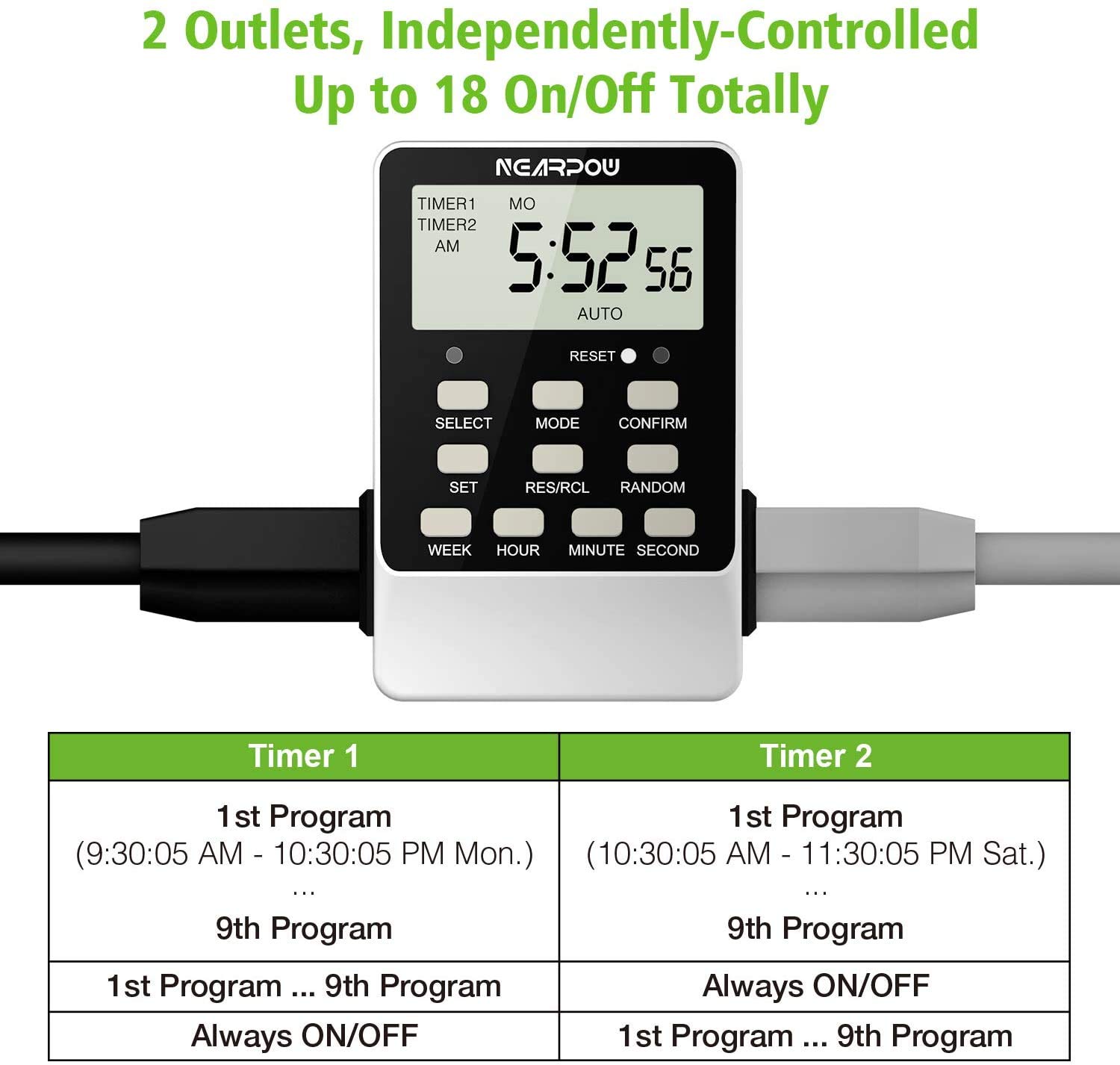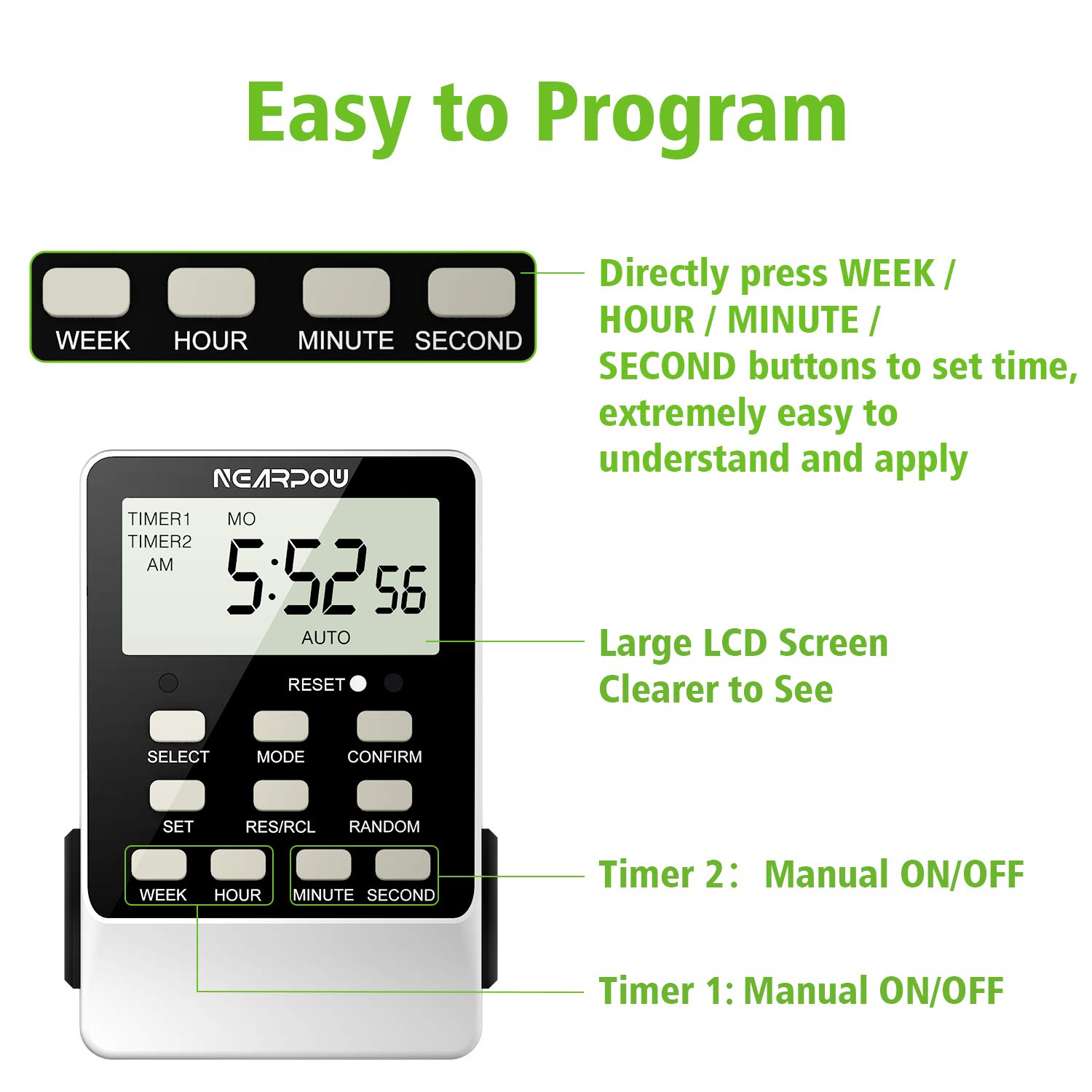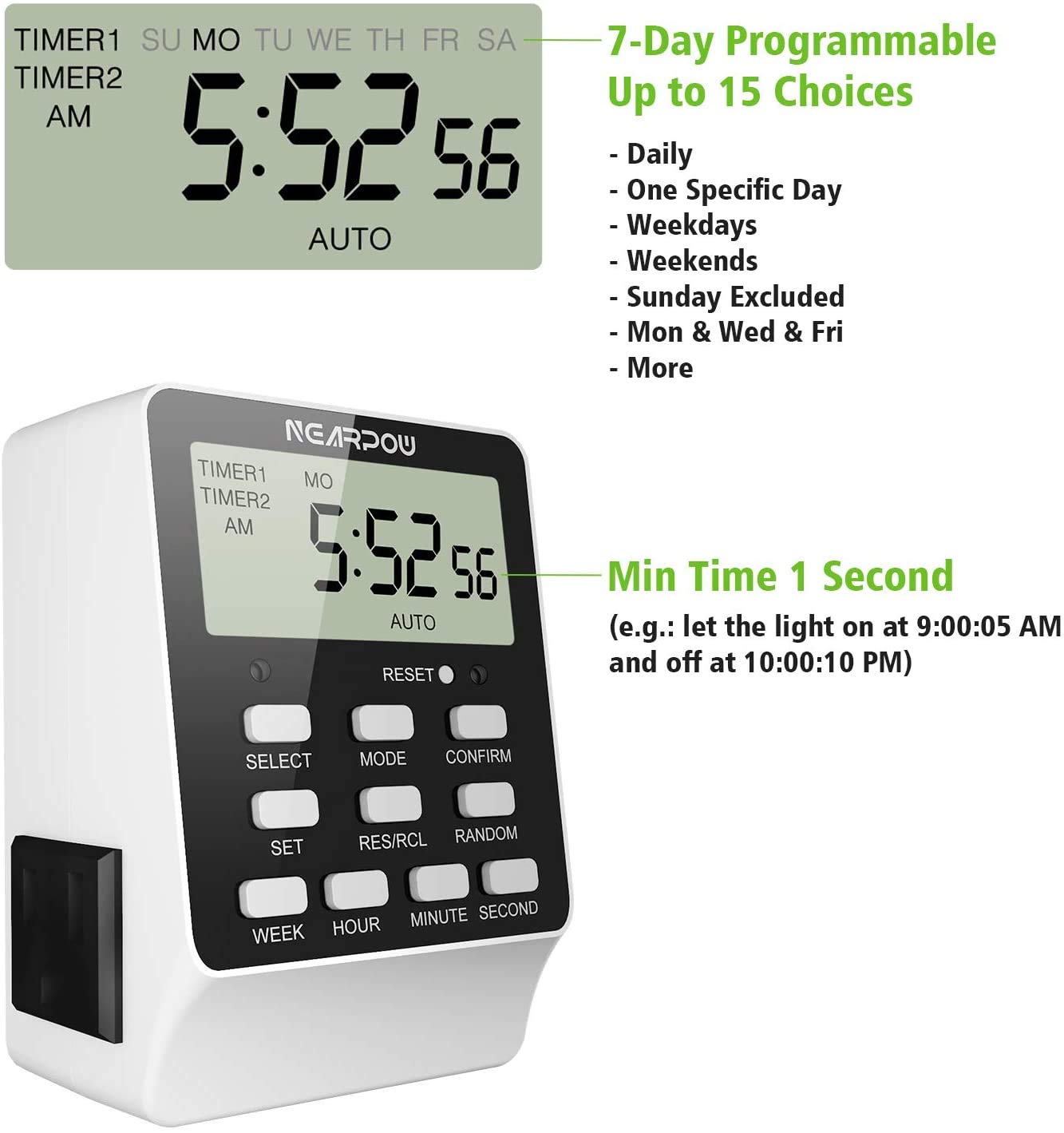![[2 Pack] Outlet Timer, NEARPOW Dual Digital Light Timer with 2 Independently-Controlled Outlets, 18 ON/Off Programs, 24-Hour and 7-Day Programmable,Indoor Electrical Timer Switch, 3 Prong, 15A/1800W](https://m.media-amazon.com/images/I/715IfHHBpzL.jpg)








🔋 Power Up Your Routine with Precision!
The NEARPOW Dual Digital Light Timer is a versatile and user-friendly outlet timer featuring two independently-controlled outlets, allowing for up to 18 programmable ON/OFF schedules. With a precise setup that can be adjusted down to the second, this timer also includes a Random Vacation Mode for added security and a Child Lock function to protect your settings. Backed by a 30-day money-back guarantee and a 12-month replacement policy, it’s the perfect solution for modern home automation.
M**N
Great timer, but it helps to know some key things the manual doesn't tell you.
Once I understood how this time really worked, my feeling afterwards was, "geesh, this really is a good timer". But it's important to know some key things because the timer's programming, doesn't really support how human's think. It just wants to be programmed and it lets you worry about all those requirements you may have that don't fit. I'm a former IT Systems Engineer, and I had some trouble with it, but my background help me understand how it works a lot easier than some others might. Hopefully by sharing some of the questions I ran into, will help others understand and use the Nearpow more easily and effectively.So my requirements centered around purchasing a timer to turn off and turn on an Internet Router, so that when I wake up the next day, the router's settings will have been refreshed. I also want to save electricity because I don't need my router on when I'm sleeping, and it also reduces the probability of hackers tapping into my network. I want the router to go off at 1am and go back on at 5am in the morning.So I get my Nearpow one afternoon and I try to set it up. The first thing you'll notice is that while it may be seemingly logical to set up (even with the lousy instructions), most people setting up a router like this will want to program their Nearpow, but continue using whatever it's programmed to turn off/on NOW. The instructions don't tell you how to do this. In my example, when I set up the on/off times, the timer was OFF, and there's no way to turn it manually ON (believe it or not). So even though it seemed easy enough to program, I had 2 very basic questions.QUESTION 1: HOW IN THE HECK DO YOU PROGRAM THIS THING, BUT BE ABLE TO USE THE DEVICE YOU'RE TRYING TO TURN ON/OFF, NOW?????QUESTION 2: HOW DO I TEST WHETHER I SET UP THE PROGRAM CORRECTLY?QUESTION 3: THE OUTLET WHERE I NEED TO PLUG THIS INTO IS TOUGH TO GET AT. ISN'T THERE AN EASY WAY TO SET IT UP, THEN PLUG IT IN WHERE I NEED TO?The answers to these questions are that you can plug this in the wall and program it wherever it's easier, then plug it into the wall socket where it needs to be working. In fact, because it has an internal battery to remember it's settings during a power failure, you can actually program the Nearpow without it even being plugged in. But I recommend that you program it with it plugged into some socket, because I believe that when it's unplugged, you will NOT be able to test your settings properly (Question 2).So with it plugged into the wall somewhere convenient, now you have the satisfaction of knowing that you can program the Nearpow somewhere where it's easier. So the majority of the customers who buy this timer, you're probably like me. You're trying to turn something on/off that you want to be able to continue to use NOW. Well, the Nearpow (believe it or not) has no manual way to turn your device on or off. Now each outlet has 9 programs where you set on and off times. When you're setting up your on and off times, the manual does NOT tell you two very important things: 1) Whichever of 9 programs you decide to set up for a given outlet, you must enter an on AND off time. 2) Secondly, for each on/off program pair, you can set up the on time to be BEFORE the off time.These two items are important because the way the programming works, you cycle through each of the 9 programs and the ON position is presented first. For some, it's logical to assume that if you wish for the outlet to go OFF first, then you might think you need to skip entering the ON time for program one, and instead just enter the OFF time. Then continuing this thinking, because you want the device to be turned ON next, you should enter your ON time next in program 2. Setting up the Nearpow this way, will NOT work. Each program must have an on and off pair.The other reason this pairing is important to understand is that if your requirements are to turn OFF the device first and then turn ON the device back on later, by setting the program pair with the ON time AFTER the OFF time, will tell the NEARPOW to turn that outlet on NOW! So now you should understand that if your requirements are like mine, you can program the Nearpow to execute at later times, but have that specific outlet turned to the ON position NOW so that you can use the device NOW. This answers Question 1.And understanding that you can program your Nearpow at a convenient outlet and turn one or both outlets ON now, aids you in being able to test whether you programmed the Nearpow properly. Simply plug in the Nearpow in any convenient outlet. Program your Nearpow with the lousy instructions but take into account the observation I've mentioned above, and you should be able to test whether each outlet works and can be programmed to go ON or OFF at a specific time. As an example, program your Nearpow to turn a device OFF ten minutes from now. After you set up the program, if set up properly, as I mentioned, that outlet's red light should be on already because your OFF time is set for a time BEFORE the ON time. Now simply wait for the OFF time to occur and the red light should go off.For those of you whose requirements are to turn something ON first, then your ON time would be BEFORE the OFF time. This case is much easier to test. You'd simply program you ON/OFF pair (say 10 minutes from now) and then wait for the red light to go on at the ON time, then go out at the OFF time.One final note:Once you program your Nearpow, if your requirements are such that your OFF time is BEFORE your ON time for an outlet, when the outlet is plugged in the socket where you programmed it, the red light will be on. But once you unplug the Nearpow to move it to it's final outlet location, the red light will go out briefly until you plug it back in. But all of your programming will still be intact, and as I mentioned before, because the outlet is ON, you can plug your device(s) in the Nearpow and continue to use them.Hope this helps others to use this device. It's great for turning a router on and off at a specific time because the timer doesn't require a WIFI connection to run properly. It simply runs off of a program that is powered by the electrical socket or a backup battery.
M**W
How to "bounce"/power-cycle a device OFF periodically -- NOT intuitive!
Instructions leave much to be desired regarding clarity.Have home security system connected to router at cottage few hours drive away. Intermittently (~monthly), some security system devices lose connection to router. Simply "bouncing" (power-cycling) the router restores connections/functionality. (Yes, have tried troubleshooting connectivity issues, but so infrequent -- and remote -- makes it difficult to diagnose.) Unfortunately, bouncing the router is hard to do from 100+ miles away. After some FRUSTRATING sessions trying to get the timer to keep the router powered except, for example, Tue and Thu mornings from 4:00:00am to 4:00:30am, finally figured it out.The timer does NOT allow a turn-on time on one day and a turn off time on a DIFFERENT day. So, using the example above, you canNOT tell the timer to set interval 1 (of 9) to turn ON on Sun at 12:00:01am, and stay ON until powering OFF on Tue at 04:00:00am. As soon as you program the Tue OFF time, it will revert the Sun ON time to Tue as well.The "trick" is a bit counter intuitive: You CAN program a single interval for a SINGLE day with an OFF time BEFORE the ON time -- and it works! Because we think logically that since the programming sequence first presents setting the ON time, that when moving next to the OFF time it MUST be later. That is NOT true -- the ON time CAN be AFTER the OFF time -- within a single day.In a nutshell:- interval ON and OFF times MUST be within the SAME day(s) of the week- if the interval's ON time is BEFORE the OFF time, the socket will be: . OFF until the ON time . ON between the two times- if the interval's OFF time is BEFORE the ON time, the socket will be: . ON until the OFF time . OFF between the two times . back ON at the ON timePHEW!
B**Z
Love the programmabilty
I thought to myself, wouldn't it be great if someone would make a two socket timer that could be programmed separately and someone read my mind! Comes in so handy for my aquarium CO2 and air pump which have to run opposite each other.
B**N
Sturdy and many options
I really like the dual output and the programming options. For some, the programming may be difficult, but just keep trying it and re-reading the instructions. I'm a techie so I figured it out fast but still had to experiment to see just how many options were available. The device has a solid design, the outlet metal is tough and the outlet inserts are solid too.
J**A
Bueno
Bueno
A**H
Good start.
I like the big, easily visible display. The independent control of 2 plugs is very handy. Be aware there are *only 9 program slots per plug* for a total of 18. From the listing, I’d expected 18 per plug. Manufacturer should add enough memory to support 24 per plug/48 total.
B**.
Hard for an old fart to set-up!
After about a half day, I got er figured out...Now working good
D**N
Great Timer!
Bought this timer for Christmas lights that I didn't want to leave on all night, but didn't want my landscape lights to be off for the rest of the night. At the programmed time, the Christmas lights came on, then at the programmed time the Christmas lights went off and the landscape lights came on. At the programmed time the landscape lights went off so no lights were on during the day. It is extremely accutate, as I set the programmed times with the clock on my phone and within seconds of that time showing on my phone the lights came on/off. Highly recommend this timer.
D**L
Works well
I use it to start my pool pump and salinator simultaneously twice a day for 4 hours per interval. Works great. Easy to program.
C**B
Highly Recommend
Excellent unit works well as a timer for our HRV system. Would recommend this Outlet Timer but found it a little complicated to program at first
B**E
Worth the money
Works like it is supposed to.
A**R
Great buy
This is clear concise and easy. You can also still use your bottom socket!
R**E
it look just like it saysand works fine
Running my sprinkers
Trustpilot
3 weeks ago
1 month ago